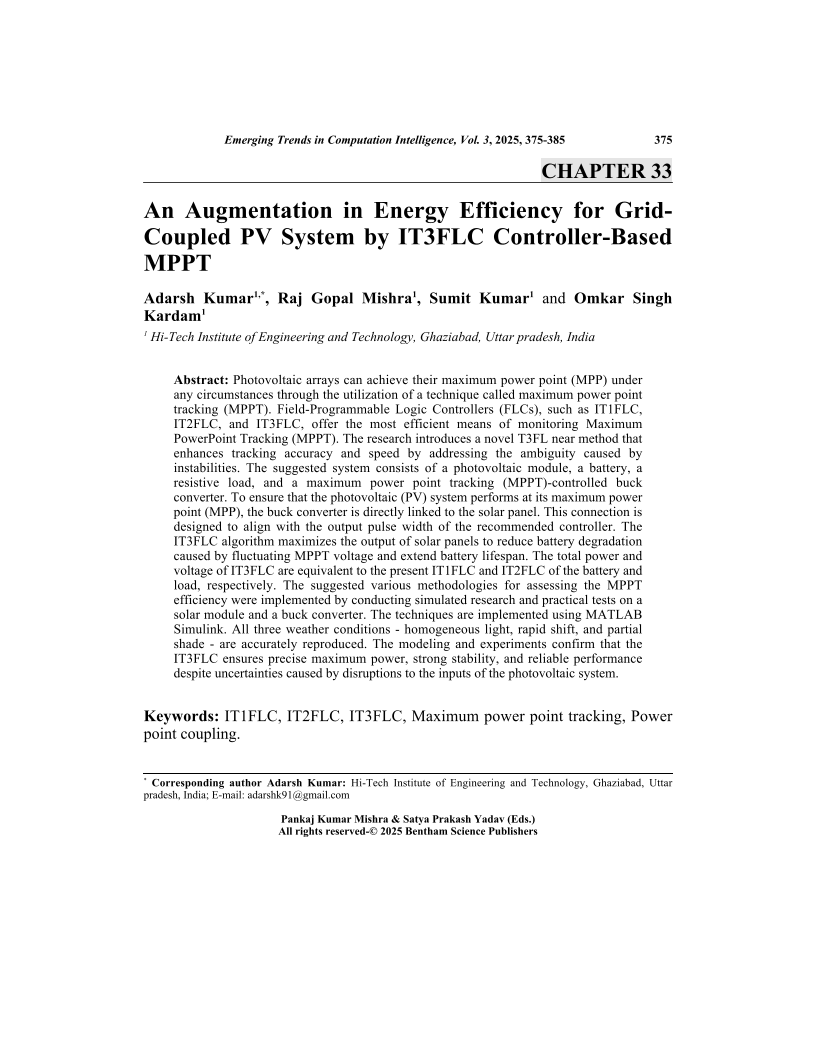An Augmentation in Energy Efficiency for GridCoupled PV System by IT3FLC Controller-Based MPPT

- Authors: Adarsh Kumar1, Raj Gopal Mishra2, Sumit Kumar3, Omkar Singh Kardam4
-
View Affiliations Hide Affiliations1 Hi Tech Institute of Engineering and Technology, Ghaziabad, Uttar Pradesh, India 2 Hi-Tech Institute of Engineering and Technology, Ghaziabad, Uttar Pradesh, India 3 Hi-Tech Institute of Engineering and Technology, Ghaziabad, Uttar Pradesh, India 4 Hi-Tech Institute of Engineering and Technology, Ghaziabad, Uttar Pradesh, India
- Source: Demystifying Emerging Trends in Green Technology , pp 375-385
- Publication Date: February 2025
- Language: English
An Augmentation in Energy Efficiency for GridCoupled PV System by IT3FLC Controller-Based MPPT, Page 1 of 1
< Previous page | Next page > /docserver/preview/fulltext/9789815324099/chapter-33-1.gif
Photovoltaic arrays can achieve their maximum power point (MPP) under any circumstances through the utilization of a technique called maximum power point tracking (MPPT). Field-Programmable Logic Controllers (FLCs), such as IT1FLC, IT2FLC, and IT3FLC, offer the most efficient means of monitoring Maximum PowerPoint Tracking (MPPT). The research introduces a novel T3FL near method that enhances tracking accuracy and speed by addressing the ambiguity caused by instabilities. The suggested system consists of a photovoltaic module, a battery, a resistive load, and a maximum power point tracking (MPPT)-controlled buck converter. To ensure that the photovoltaic (PV) system performs at its maximum power point (MPP), the buck converter is directly linked to the solar panel. This connection is designed to align with the output pulse width of the recommended controller. The IT3FLC algorithm maximizes the output of solar panels to reduce battery degradation caused by fluctuating MPPT voltage and extend battery lifespan. The total power and voltage of IT3FLC are equivalent to the present IT1FLC and IT2FLC of the battery and load, respectively. The suggested various methodologies for assessing the MPPT efficiency were implemented by conducting simulated research and practical tests on a solar module and a buck converter. The techniques are implemented using MATLAB Simulink. All three weather conditions - homogeneous light, rapid shift, and partial shade - are accurately reproduced. The modeling and experiments confirm that the IT3FLC ensures precise maximum power, strong stability, and reliable performance despite uncertainties caused by disruptions to the inputs of the photovoltaic system.
-
From This Site
/content/books/9789815324099.chapter-33dcterms_subject,pub_keyword-contentType:Journal -contentType:Figure -contentType:Table -contentType:SupplementaryData105

